|
Click Here to view this email in your browser
NACDEP 2023 Winter Newsletter
NACDEP Colleagues: Greetings. I hope everyone had a wonderful holiday season and that we are all excited and ready for a productive and satisfying 2023. We are getting off to a good start with a nice winter newsletter for you to read. I just want to drop a reminder that the NACDEP Conference is early this year. So be on the lookout for an early first call around the end of March.
I also want to express my thanks to everyone who contributes to and reads the newsletter. It is a great tool for all of us. If you ever wish to talk to me about any aspect of the newsletter, feel free to get in touch with me. You can phone my cell at 330-466-7877 or email me at [email protected] For now, enjoy the current issue.
Sincerely,
Thomas W. Blaine, PhD
Associate Professor
Ohio State University Extension
NACDEP Newsletter Editor
President's Column
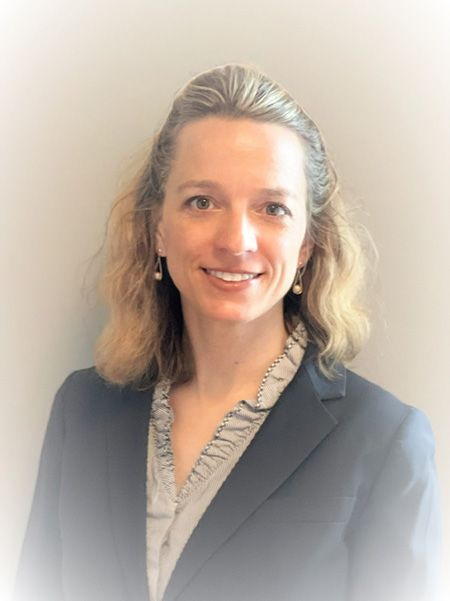
Submitted by Rebekka Dudensing, NACDEP President
A Season for Everything
In the last newsletter, I told you I love fall. Let me now share with you that I hate winter. It’s cold and dark. After the glitter and twinkling lights of December, January and February are particularly drab and dull. Growing up, it was calving season, and in my adult life, winter is the height of lambing season, which means extra work and less sleep. In the office, January and February bring calendar year reports (not to be confused with fiscal year reports), CV updates, and annual reviews.
But…and there’s always a “but,” right?...winter also brings new life. Not just farm animals, but new purpose, new plans, and new programs.
On January 12, we celebrated our second annual NACDEP New Year with a New Year ReSolutions theme. Some of our members shared their award-winning programs, which may offer solutions for our own programs and our communities. A few committees offered tips and solutions for submitting conference presentations and award nominations. The DEI committee facilitated discussions to help us recognize barriers and potential solutions to help foster inclusivity in our organization, our communities, and our lives. I hope that each of you was able to find some solutions in the NACDEP New Year event. Personally, I recommitted to learning, especially to connecting with and learning about individuals.
If you’re looking for more inspiration, ideas, and connection, the Extension Leadership Conference will be in Kansas City February 7-9. The Public Issues Leadership Development conference in Washington, DC, brings together Extension professionals across disciplines to learn to communicate Extension’s value. Our own April 30-May 3 NACDEP conference in Couer D'Alene, Idaho, will be here before we know it with opportunities to share, learn, and connect.
Before we know it, spring will have us out and about in constant activity, helping communities sow the seeds of change. Summer will bring a mix of tilling, harvests, and fun. Then we can again engage in scholarly reflection in the fall. Now is the season of preparation, planning the year and creating fertile ground for all that follows.
Rebekka Dudensing,
NACDEP President, 2022-23
2023 NACDEP CONFERENCE IS JUST AROUND THE CORNER!

Idaho welcomes you!
April 30-May 3
Coeur d’ Alene, Idaho
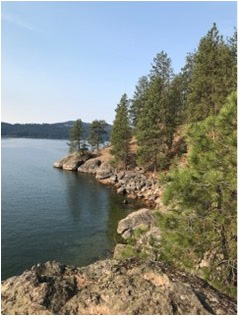 Mobile Workshops Mobile Workshops
E-Bike North Idaho Centennial Trail Tour
Panhandle Corridor Farm Tour
Innovation Den and Innovative Collective Tour
GIZMO Maker Space & North Idaho College Tour
Cataldo Mission & Wallace, ID Tour
CDA Tribal Cultural Tour
Interpretive CDA Lake Boat Tour

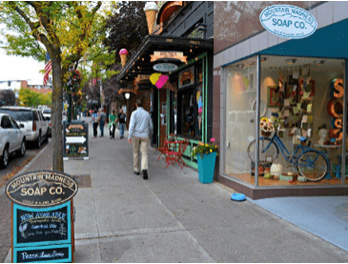 Schedule Highlights Schedule Highlights
Welcome Event on the Lake
“Homecoming” Celebration
State/Region’s Night Out
Award Dinner
Lunch on the Town
Keynote Speaker: Dr. Paccione

Important Dates!
Proposals Due: Jan 18th
Look For Our NACDEP Conference Link, Coming Soon!
Early Bird Registration: Feb 1st
Regular Registration: March 1st
Questions?
Katie McFarland, Conference Co-Chair
[email protected]
Dear Members of the National Association of Community Development Extension Professionals
A Model of Momentum Shifts in Community Change for Rural Prosperity
Submitted by: Shawn Kaskie, a Doctoral Student representing a research team from the University of Nebraska-Lincoln, Department of Agricultural Leadership, Education, and Communications (ALEC).
Additional project team members from the department include Lindsay J. Hastings, Ph.D. Clifton Professor in Mentoring Research, Research Director, NHRI Leadership Mentoring, and Principal Investigator. Justine Yeo, Doctoral Student and Graduate Assistant.
As community development professionals, we are always seeking ways to understand and address the complex factors that drive positive change in the communities we serve. There are many factors related to community change, including social, economic, and political forces that can impact a community's development. In rural communities, these factors can be particularly influential, as these communities often face unique challenges related to access to resources, population size and density, and distance from larger urban centers. Internal and external factors such as individual and collective actions are also important but often less obvious to local stakeholders. Some of the internal factors that can influence community change include community resources and assets, community capacity and readiness for change, and community values and culture. External factors that can impact community change include economic conditions, social and political forces, and environmental factors like the Covid-19 Pandemic or natural disasters including floods, droughts and tornadoes.
According to rural community development theory, community change can also be influenced by the presence of social capital, which refers to the networks, norms, and trust that exist within a community. When a community has high levels of social capital, it is more likely to have the resources and support needed to implement effective development strategies and to sustain positive change over time. This model supports that theory as effective leadership, trust in those leaders, collaboration, volunteerism, and engaging for action may be required to sustain positive long-term change in response to negative economic or social trends that impacts the community.
Specific challenges and opportunities may arise in relation to community change. Rural community development theory highlights the importance of taking a holistic approach to addressing these challenges, considering the interrelatedness of economic, social, and environmental issues. This may involve building upon existing community strengths and assets, fostering collaboration and partnerships, and leveraging resources and support from external sources.
We are pleased to share with you the findings of a recent qualitative study of community change at the University of Nebraska-Lincoln. Our data collection methods included asking over 44 experienced community development researchers, practitioners, and local leaders in over 20 Nebraska organizations from around the state a series of questions in moderated focus groups with Dr. Lindsay Hastings and two graduate students, Justine Yeo and Shawn Kaskie. The focus group findings were analyzed using a Phenomenological qualitative research approach.
Figure 1. Community change includes antecedent conditions, strategies, and outcomes
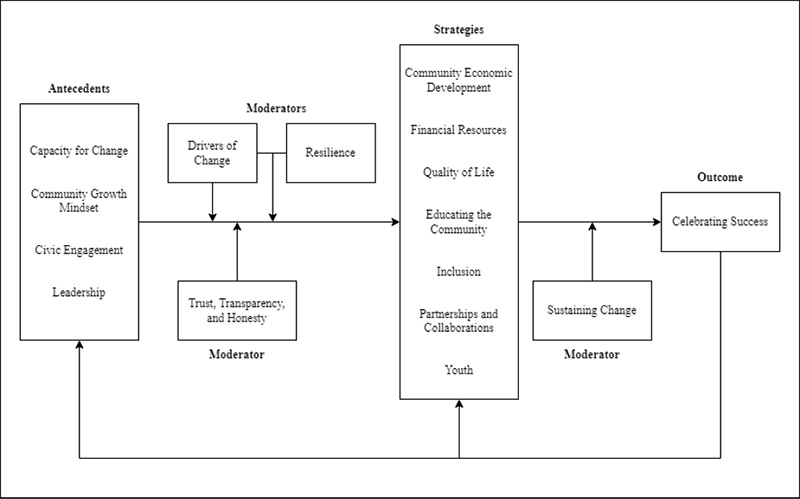
Overall, the study found that positive community change begins with the community having the "right stuff" in place, such as the capacity for change, a community growth mindset, a sense of civic engagement, and effective local leadership. With these conditions in place, strategies can then be implemented successfully to create long-lasting change within the community. These strategies range from community economic development efforts to partnerships and collaborations across communities.
For change to begin within a community, participants described the community needing to have several characteristics in place: the capacity for change, a community growth mindset, strong civic engagement, and effective leadership. One important factor related to community change is the community's capacity for change, which includes the community's ability to identify and address its own needs and to work towards the collective goal of positive change. This capacity can be influenced by a number of factors, including the community's social and economic resources, the level of engagement and participation among community members, and the presence of effective local leadership. Another important pre-cursor for positive change can be with the local culture having a community growth mindset. This represents a positive community-wide openness to change and new ideas for the betterment of the entire community. This mindset also involves an emotional labor of love as community members set their self-interests aside, choose to work for the common good, and dream about the community’s future. One participant described it as:
“New visions about what was possible and then began to demonstrate what was possible. That began to drive belief of the community, that it could have a different kind of future, which then led to other things...”
Beyond this, participants also expressed the value of civic engagement and leadership in order for the community to evolve and grow. Civic engagement describes the community’s sense of responsibility and involvement in efforts to help the community thrive. This sense of civic duty leads to clear initiatives taken by community members as they freely give away their time and their skills.
The role of leadership and community involvement is crucial in facilitating community change. Engaging community members in the planning and decision-making process can help to build buy-in and ownership, and effective leadership can help to guide and support the community through the change process.
Four additional factors were found to be related to the process of positive community change. They moderate the power of the process and can impact the final success of community development outcomes indirectly. Externally-caused drivers of change such as the Covid-19 pandemic, drought, floods, tornados, and economic downturns such as the 1980’s ag-crisis were commonly reported external shocks to the community often motivating a collective response. These positive responses to change, or resilience, is the capacity to bounce back or recover even stronger from the negative events or drivers. Trust, transparency, and honesty between the community, its leaders and civic groups are also important intangible elements impacting the efficiency of the community development process.
Ultimately, community development strategies aimed at building capacity produce successful positive change when local efforts can sustain that change over many years and challenges. Sustaining change is the community’s long-term ability to keep moving forward with planned strategies and to maintain efforts to leverage the community’s local strengths and uniqueness. Essentially, a community’s ability to maintain change creates momentum and influences the impact of community strategies on successful community change. Efforts that help sustain change include empowering new and diverse stakeholders, as described by one participant:
“the community themselves are still really noticing what needs to be improved, and don't always recognize that shift that's happening locally. But when they start to bring people from the outside, they start to get some of that energy…”
The experience of community change appears to be both a cyclical and sequential process. Successful change further strengthens the community's antecedent conditions and development strategies, and once the process of community change begins and concludes with celebrations of success, the whole process repeats over and over again, creating prolonged change over time.
We hope that these findings will be useful to you as you work to facilitate positive community change in your own communities. If you have any questions or would like to discuss these findings further, please contact me at [email protected]
References
Blanke, A., & Walzer, N. (2013). Measuring community development: what have we learned? Community Development, 44(5), 534 – 550. https://doi.org/10.1080/15575330.2013.852595
Borich, T., Chazdon, S., Leuci, M., & Loveridge, S. (2013). Common impact indicators in Extension community development [Powerpoint slides and presentation]. Retrieved from: http://ncrcrd.msu.edu/ncrcrd/topic_area_fundamentals_for_extension_professionals.
Clark, P., & Gong, T. (2011). Developing leadership competencies to promote the community
development of the Mississippi Delta Region. Journal of Rural and Community
Development, 6(2), 135 – 154.
Community Indicators Consortium. (2019). Indicator projects. Retrieved from: https://communityindicators.net/indicator-projects/.
Emery, M., Fernandez, F., Gutierrez-Montes, I., & Flora, C.B. (2007). Leadership as community capacity building: A study on the impact of leadership development training on community. Community Development, 38(4), 60 – 70. https://doi.org/10.1080/15575330709489819
Emery, M. & Flora, C. (2006) Spiraling-Up: Mapping Community Transformation with Community Capitals Framework. Community Development. 37:1, 19-35, DOI: 10.1080/15575330609490152
Etuk, L., Rahe, M., Crandall, M., Sektnan, M. & Bowman, S. (2013). Rural leadership development: pathways to community change. Community Development, 44(4), 411 – 425.
Etuk, L., & Sektnan, M. (2012). Evaluation of the Ford Institute Leadership Program: 2011 report. Retrieved from https://ir.library.oregonstate.edu/concern/technical_reports/qj72pd04v.
Franz, N. K. (2011). Advancing the public value movement: Sustaining Extension during tough times. Journal of Extension, 29(2), Article 2COM2. Available at: https://www.joe.org/joe/2011april/comm2.php
Franz, N. K. (2013). Improving Extension programs: Putting public value stories and statements to work. Journal of Extension, 51(3), Article 3TOT1. Available at: https://www.joe.org/joe/2013june/tt1.php
Fischer, J., & Siddiq, F. (2013). Trends in Metropolitan and Non-Metropolitan Populations in Canada. Woodrow Wilson International Center for Scholars. From https://www.wilsoncenter.org/sites/default/files/fazley_final_paper.pdf
Hunter, L. M., Talbot, C.B., Connor, D.S., Counterman, M., Uhl, J. H., Gutmann, M. P., & Leyk, S. (2020). Change in U.S. Small Town Community Capitals, 1980–2010. Population Research and Policy Review. 39(pp.913–940).
Kalambokidis, L. (2004). Identifying the public value in Extension programs. Journal of
Extension, 42(2), Article 2FEA1. Retrieved from
http://www.joe.org/joe/2004april/a1.php.
Kalambokidis, L., Hinz, L., & Chazdon, S. (2015). Using economic principles to show how Extension programs create public value. In J. M. Bryson, B. C. Crosby, and L. Bloomberg (Eds.), Creating public value in practice: Advancing the common good in a multisector, shared-power, no-one-wholly-in-charge world (pp. 311 - 330). Routledge. https://doi.org/10.1201/b18116
Loveridge, S., & Elrod, B. (2016, April 25). The importance of collecting impact numbers to promote community development work. National CRD Indicators Webinar Series. Retrieved from: http://rrdc.info/national_indicators.html.
McCrea, R., Walton, A., & Leonard, R. (2016). Developing a Model of Community Wellbeing and Resilience in Response to Change. Social Indicators Research (2016) 129:195–214 DOI 10.1007/s11205-015-1099-y
Morse, G., French, C., Scott, C. (2016). Impact indicators tips booklet. North East Regional Center for Rural Development. Retrieved from: http://aese.psu.edu/nercrd/impacts/impact-indicators-tips-booklet.
North Central Regional Center for Rural Development. (2010). Community resource and
economic development (CRED): Programming impacts report. Retrieved from:
https://www.canr.msu.edu/ncrcrd/state_extension_leader_section1/impact_reports.
North Central Regional Center for Rural Development. (2019). Extension community
development impacts. Retrieved from
https://www.canr.msu.edu/ncrcrd/state_extension_leader_section1/impact_reports
Nichols, A., Blake, S.M., Chazdon, S., Radhakrishna, R. (2015). From farm results demonstrations to multistate impact designs: Cooperative extension navigates its way through evaluation pathways. Journal of Human Sciences and Extension, 3(2), 83 – 107.
Peters, D. (2017). What Drives Quality of Life in Iowa Small Towns? Ames: Iowa State University Extension Store. From https://store.extension.iastate.edu/product/15124
Pigg, K., Gasteyer, S., Martin, K., Apaliyah, G., & Keating, K. (2015). Community effects of
leadership development education: Citizen empowerment for civic engagement.
West Virginia University Press.
Postelnicu, M. (2016, November 28). Two-step flow model of communication. Encyclopedia Britannica. https://www.britannica.com/topic/two-step-flow-model-of-communication
Rossi, P. H., Lipsey, M. W., & Henry, G. T. (2018). Evaluation: A systematic approach. Sage Publications.
Setknan, M., Etuk, L., Bowman, S., & Rennekamp, D. (2010). Evaluation of the Ford Institute Leadership Program: 2009 report. Retrieved from https://ir.library.oregonstate.edu/concern/technical_reports/pg15bk62p.
Setknan, M., Rahe, M., Etuk, L., & Bowman, S. (2011). Evaluation of the Ford Institute Leadership Program: 2010 report. Retrieved from https://ir.library.oregonstate.edu/concern/technical_reports/47429f422.
Success Measures. (2019). Measurement tools. Retrieved from: https://successmeasures.org/measurement-tools.
Vincent, N., Ward, L., & Denson, L. (2015). Promoting post-conventional consciousness in leaders: Australian community leadership programs. Leadership Quarterly, 26, 238 – 253. https://doi.org/10.1016/j.leaqua.2014.11.007
Walzer, N., Weaver, L., & McGuire, C. (2016). Special issue on collective impact. Community Development, 47(2), 156-166.
Wituk, S., Ealey, S., Clark, M. J., Heiny, P., & Meissen, G. (2005). Community development through community leadership programs. Community Development, 36(2), 89 – 101. https://doi.org/10.1080/15575330509490177
Woolcock, M., & Narayan, D. (2000). Social capital: Implications for development theory, research, and policy. The World Bank Research Observer, 15(2), 225 – 249. https://doi.org/10.1093/wbro/15.2.225
A UF/IFAS Extension Climate Resiliency Program Helps Reduce Costs for Communities and Individuals in Monroe County, Florida
Submitted by Alicia Betancourt
University of Florida Extension
Relevance
Many of the nation's southeastern cities are increasingly at risk due to heat, flooding, sea-level rise, and vector-borne disease brought about by the changing climate. The combined effects impact property values and infrastructure viability, particularly in coastal cities. In 2017, Moody’s Investors Service issued a report to cities that they will be evaluated, in part, on how they prepare for both short-term climate shocks and longer-term trends associated with climate change. According to the House Select Committee on the Climate Crisis, cities that invest in climate preparedness would see a higher bond rating, allowing them to attract more low-interest capital to invest in a broader range of strategies to prepare for the short and long-term impacts of climate change. Cities that have not developed climate-resilient policies and investments could be at a credit disadvantage.
Response
Extension agents work on many issues and at many levels to help improve individual, family, and community well-being in Florida. Because climate change is one of the biggest current issues and affects several aspects of society, Extension programming related to climate has increased in recent years. One such program is the University of Florida Institute of Food and Agricultural Sciences (UF/IFAS) climate resiliency program in Monroe County. The program has promoted the increase of climate-resilient actions by individuals and governments through education, outreach, and tools to reduce risk. Extension agents provide training and direct assistance to local governments, allowing Florida cities to develop local solutions specific to their shocks and climate trends. For individuals, this program increases critical decision-making skills about the impacts of individual choices on climate change. Residents learn about climate change and risk in terms that are understandable to the public. Individuals learn to change daily habits around consumption and waste and implement home efficiency improvements. These behaviors can increase efficiency, reduce spending and encourage a healthier lifestyle in the individual. Educational outreach provided in this program supports the National Flood Insurance Program (NFIP) Community Rating System (CRS) and Program for Public Information (PPI) so that people in the community are educated about the flood hazard, flood insurance, the natural functions of floodplains, and flood loss reduction measures. The PPI program credits educational outreach initiatives through flood insurance premium reductions determined by a communities CRS Class.
Results
To address the problem of climate change people must be given the knowledge and resources to act to reduce risks. Extension programs that are targeting local government and citizens result in improved economic prospects through high bond ratings and reduced cost of flood insurance. The combined effort of the UF/IFAS Extension agent, eight community members, and 11 municipal staff has enabled Monroe County to reach CRS Level 4 designation which saves each flood policyholder in the county 25% for an average of $373 per year for a county-wide total of $5.3 million. The program received a level 3 designation in April 2022 for a discount of 35%, one of only two communities in Florida to earn that designation.
Public Value Statement
Communities that are preparing for the short and long-term impacts of climate change, are the result of adaptation and actions taken by community members that promote increased climate resilience. Extension outreach programs designed to educate on reducing risk by targeting local government and citizens with tools and information result in improved economic prospects through high bond ratings and reduced cost of flood insurance.
Statement Synopsis
A UF/IFAS Extension climate resiliency program in Florida's Monroe County increases climate-resilient actions by individuals and governments through education outreach and tools to reduce risk. UF/IFAS Extension agents provide training and direct assistance to local governments, allowing Florida cities to develop local solutions specific to their shocks and climate trends.
Award Winners
Submitted by Tamara Ogle
Purdue Extension Community Development
Join us in congratulating our 2022 NACDEP Award Winners! We will feature a few of our national winners in each newsletter. This is another opportunity to share some of the excellent community development work of our NACDEP members.
And while you are learning more about our fabulous award winners, remember that this could be you next year. The NACDEP 2023 Awards portal is open until January 31, 2023, 11:59 pm.
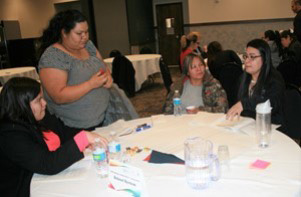
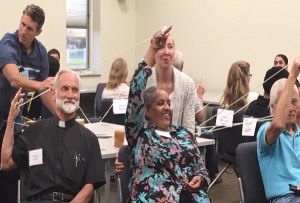
The Welcoming Communities Project
2022 NACDEP Diversity Team Award Winner
Toby Spanier, Neil Linscheid, Jocelyn Hernandez-Swanson, Nancy O’Brien, Scott Chazdon, Julie Hawker, Tami Skinner, and Mohamed Alsadig
The Welcoming Communities Project began five years ago as a collaboration with the Region Nine Development Commission and the Greater Mankato Diversity Council in south-central Minnesota. Originally called the Rural Equity Learning Community, the program started with conversations on race and evolved into a seven-month community cohort program, with content related to diversity and inclusion, the economics or “business case” for inclusion, and skill building to help communities hold complex and difficult conversations. A community assessment process (see this article in the Journal of Extension) has helped community members gain a baseline, action-oriented understanding of inclusion in seven sectors of their community – schools, health care, law enforcement, local government, nonprofit organizations, religious organizations, and business.
The most important strength of this team is its ability to adapt as on-the-ground experience and major events, such as pandemic workforce shortages and the killing of George Floyd, heightened the urgency of DEI work. In recent years, the team has expanded to new parts of the state, adding new staff and partner organizations. Interestingly, northern MN communities have smaller immigrant populations and are focusing on a broader notion of inclusion, with attention to low-income, LGBTQ, disabled, as well as BIPOC community members.
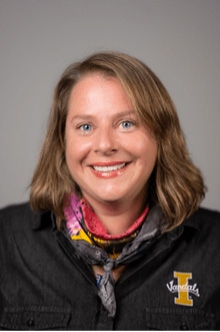
Diversity Learning Circle in the West Central Mountains of Idaho
2022 NACDEP Diversity Individual Award Winner
Melissa Hamilton, University of Idaho
Extension educators are responsive to community events, and in May of 2020, the nation was mourning the death and murder of George Floyd. Extension educator Melissa Hamilton responded to her rural Idaho community by offering a Diversity Learning circle. She partnered with a local faith leader, Jon Umbdenstock, with the New Meadows Methodist Church to develop and provide virtual discussions two times per month over a six-month period. The DLC challenged participants to explore implicit bias and increase their racial understanding in their community and across the nation. The DLC challenged participants to be intentional about being anti-racist in a world where implicit bias and racism are integrated throughout society. The DLC led six months of facilitated conversations engaging rural citizens in relevant and current civil discussions. The program utilized the following curriculum sources: Coming Together for Racial Understanding open-source content, Justice in June, book review, and special guest interviews.
You can learn more about the program details on the NACDEP YouTube channel here:
https://www.youtube.com/watch?v=1jltDjgOlrE
And reviewing the University of Idaho Impact Statement:
https://www.uidaho.edu/-/media/UIdaho-Responsive/Files/Extension/admin/Impacts/2021/26-21-mhamilton-diversity.pdf
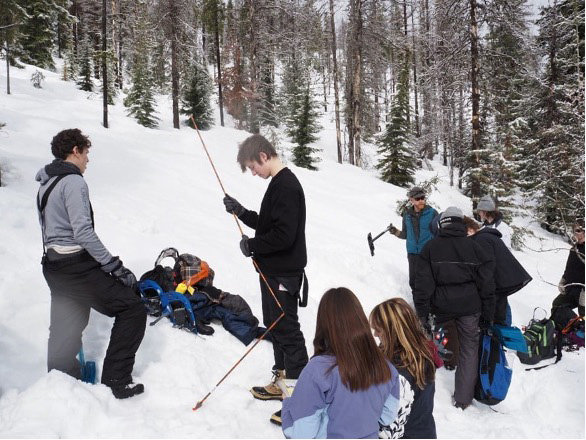
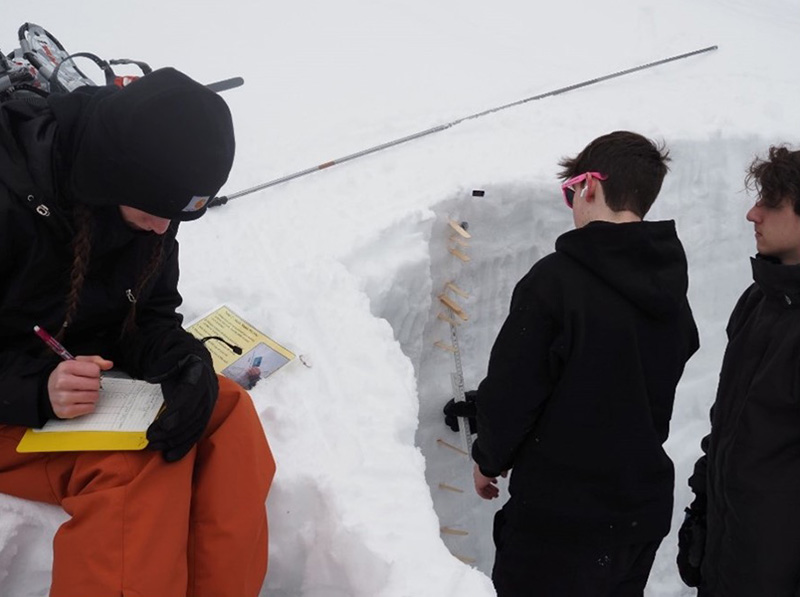
The Confluence Project Snow Science Instructional Video
2022 NACDEP Educational Materials Individual Award Winner
James Ekins, University of Idaho
Communities throughout the western U.S. rely on the mountain snowpack as the largest natural water reservoir. Winter snow builds up in the mountains, then slowly melts into our streams, lakes, and groundwater. This cycle provides water for agriculture, hydropower, industrial and municipal use, aquatic ecosystems, and recreation during the West’s uniquely dry summer months. Water security is an increasingly pressing issue. Low snowpack years are becoming more common, diminishing water availability for all.
University of Idaho Extension Water Outreach is a longstanding contributor to a high school watershed field science program called The Confluence Project (TCP). One major component of TCP is snow science. We lead the students on snowshoes into the Bitterroot Mountains near Lookout Pass, Idaho. Students measure the snowpack for snow-water-equivalent (SWE) the same way as professionals do. With these data, students return to the classroom to make water availability predictions for the upcoming summer. Students then compare their data with 50-75 years of automated SWE measurements to see for themselves the direct impact of climate change on community water availability.
Extension Water Outreach produced an educational video about these snow science field experiences for the students, teachers, parents, and community volunteers. The video covers critical topics like layering and staying warm in winter in the mountains, how to wear and use snowshoes, how to dig a proper snow pit for accurate measurements, and each of the snow science measurement techniques. It also acknowledges all the TCP instructors, community partners, and funding organizations.
The Newsletter Editor is Available to Address Your Peer or Clientele Groups
Submitted by Thomas W. Blaine, PhD
Associate Professor
Ohio State University Extension
Over the past two years, I have been fortunate enough to be invited to address two different groups around the country through my association with NACDEP. In 2021, it was The University of Missouri Extension where I addressed Global Climate Change. In April of 2022 it was the NACDEP North Central Region on Engaging Extension Audiences on Controversial Public Issues.
I am open to presenting to any group you have, whether peer or clientele, and at any level you wish – county, regional state, etc. I have presentations in the two areas I listed above and also a third, which I have been giving in Ohio about how to get your work published in peer reviewed journals. The duration of each is flexible, but I generally prefer 45 minutes with an additional 15-30 minutes for Q&A.
Here are the presentations:
(1) Global Warming/ Climate Change: I answer the following questions in this presentation:
Isn’t it true that global temperatures have always changed?
Hasn’t Earth been much warmer in the past than it is now?
How do we know that current warming is caused by humans and not just natural variation?
Does a temperature rise of a few degrees really matter much? After all, the temperature where I live can change 20-30 degrees in one day!
Who came up with the idea that humans can alter Earth’s climate anyway?
As a PhD in Environmental Economics, I have been teaching and writing about global warming/climate change for 35 years. I have given seminars on the topic in the former Soviet Union, Brazil, and to the US Navy while at sea returning from surge deployment. The presentation I offer here covers all the basics of global warming/climate change.
(2) Engaging Extension Audiences on Controversial Public Issues
Extension educators and specialists never know when a topic is going to emerge in their county or state requiring their expertise that addresses a controversial public issue. Examples include: obesity, teen pregnancy, the opioid epidemic, COVID-19, land use, personal debt, and others. Conducting educational programs on these topics can put Extension personnel into positions where they feel extremely uncomfortable.
This presentation can remove some of the uncertainty that drives the fear of addressing these issues by (a) providing a comprehensive theoretical framework for categorizing topics and controversies and (b) delineating roles that Extension personnel can take in identifying the part they feel most comfortable in playing in efforts to address these topics based on their own level of expertise as well as their preferences and goals.
I created this initiative in the early 2000s after publishing two articles on the topic in JOE (2000 and 2001) co-authored with my colleague Dave Patton. Having been engaged in education addressing a host of controversial issues throughout my career, I know very well how educators can become overwhelmed when topics get divisive. But I also understand that in order to remain relevant in the future, Extension must continue to address many of these issues, and I enjoy helping to prepare my colleagues for the times when they will be engaging in teaching topics that can seem intimidating at first, but turn out to reflect why we initially came into Extension in the first place.
(3) Publishing Your Work in Peer Reviewed Journals
Publishing our work in peer reviewed journals carries a lot of rewards for the author, their Extension organization, and the readership of these works. But many Extension professionals are intimidated when considering submitting their work for peer review. Reasons for this include fear of rejection and just not knowing how to get started.
This presentation features a straightforward path that the participant can follow on the road to publication. We start with the basics of how to become familiar enough with a body of literature that relates to what the Extension professional is already doing, and then move to how this new knowledge can modify programs, which, in turn can generate new concepts or new data that would be of interest to journal readers.
We go through manuscript preparation and submission to how to respond to reviews, be they highly critical or highly positive. The presentation emphasizes that while nobody initially likes to see negative reviews of their work, many of the best articles in the literature only became the excellent pieces that they are because authors had to make some important revisions based on what were, in fact, harsh reviews.
I have published dozens of peer reviewed articles in journals, fact sheets, and conference proceedings. I currently review about 20-25 manuscripts for various journals per year, and have served as a reviewer for JOE since 2007. I enjoy taking the experiences I have had as an author and as a reviewer and helping colleagues achieve the goals of publishing their work in peer reviewed outlets of all kinds.
So there you have it
I am offering all of these programs via Zoom to any group you wish. Regional reps, Extension educators, specialists, administrators, newsletter readers in general: I look forward to hearing from you. My cell is 330-466-7877, and my email is [email protected]
Texas A&M AgriLife Extension Position Opening
Assistant Professor and Extension Specialist, Community Economic Development
|